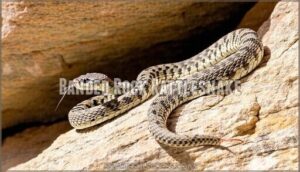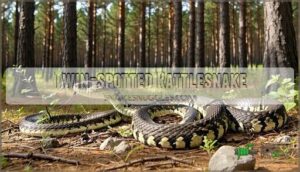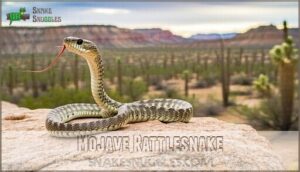This site is supported by our readers. We may earn a commission, at no cost to you, if you purchase through links.

Environmental factors like temperature, prey availability, and habitat quality substantially influence both final length and growth rate. Unlike many animals, rattlesnakes continue growing throughout their lives, though the pace slows considerably after reaching sexual maturity.
This lifelong growth pattern makes age estimation through size alone unreliable, since environmental conditions can create surprising variations in snake dimensions across different regions and habitats, which is a result of environmental factors.
Table Of Contents
- Key Takeaways
- Rattlesnake Growth Factors
- Various Rattlesnake Species
- Maturation and Length
- Seasonal and Environmental Influences
- Safety Measures and Awareness
- Frequently Asked Questions (FAQs)
- How fast do rattlesnakes grow?
- How long do baby rattlesnakes grow?
- How long do rattlesnakes live?
- How big do rattlesnakes get?
- How do rattlesnakes grow?
- How long do rattlesnakes get when they hatch?
- How long does it take for a rattlesnake to grow its first rattle?
- What factors affect the growth rate of rattlesnakes?
- How does the environment impact rattlesnake growth?
- What are some safety measures to take when encountering rattlesnakes?
- Conclusion
Key Takeaways
- You’ll find that rattlesnake sizes vary dramatically by species – pygmy rattlesnakes stay tiny at 16-20 inches, while western diamondbacks can reach up to 7 feet in rare cases.
- You can’t accurately estimate a rattlesnake’s age from its size, since they continue growing throughout their entire lives, with growth rates heavily influenced by food availability, temperature, and habitat quality.
- You shouldn’t rely on counting rattle segments to determine age – young rattlesnakes shed frequently (up to 3 times yearly), while adults shed less often, and segments break off over time.
- You’ll see the fastest growth in young rattlesnakes during their first 2-3 years, with growth slowing dramatically after they reach sexual maturity at around 3-4 years old.
Rattlesnake Growth Factors
You can’t judge a rattlesnake’s age just by counting its rattle segments since they break off and aren’t reliable markers.
Several key factors control how fast these snakes grow, including food availability, temperature, and habitat quality.
Rattle and Growth Correlation
Rattle-growth correlation reveals fascinating Snake Growth Rate patterns in these remarkable reptiles. Young rattlesnakes experience rapid Segment Addition during growth spurts, creating distinctive Rattle Size markers. Their Rattlesnake Growth directly impacts rattle development and future Snake Length potential.
Key growth indicators include:
- Tapered rattle segments signal recent rapid growth phases
- Wider, robust segments mark years of excellent nutrition
- Frequent shedding creates more rattle segments quickly
- Broken segments can erase growth history records
This Rattle Noise maker grows with each shed, reflecting Rattlesnake Size Variations and Growth Patterns throughout their lives. Understanding Rattlesnake Growth is essential for analyzing these patterns.
Shedding and Age Estimation
You can’t count a rattlesnake’s age by its rattle segments alone. Each time these snakes shed their skin, they add one rattle segment. However, shedding patterns vary widely based on food availability and temperature.
Young rattlesnakes might shed three times yearly, while adults shed less frequently. This makes age determination tricky through molt cycles alone. Understanding snake shedding tool methods can help in this process, particularly in understanding shedding patterns.
Shedding frequency drops with age—young snakes molt three times yearly while mature adults shed just once, making rattle counting unreliable for aging
Environmental Impact on Growth
Several factors shape how big rattlesnakes grow. Habitat Quality determines access to shelter and prey. Climate Effects matter most – cooler, wetter areas produce larger snakes than hot, dry regions. Food Availability controls rattlesnake growth rates since hungry juveniles develop slowly.
Water Sources support healthier ecosystems with more prey. Terrain Influence affects Snake Size Variations across landscapes. Understanding Wildlife Ecology helps explain these Rattlesnake Development patterns and rattlesnake size differences you’ll encounter.
These snakes play a critical ecological role by controlling rodent populations.
Various Rattlesnake Species
You’ll find rattlesnakes come in many sizes, from tiny pygmy rattlers barely over a foot long to massive eastern diamondbacks that can stretch eight feet.
Each species has its own growth pattern and maximum size, making it important to know which type you might encounter in your area, especially when dealing with eastern diamondbacks.
Pygmy Rattlesnake
The pygmy rattlesnake proves that good things come in small packages. Adults average just 16-20 inches, making them one of North America’s smallest venomous snakes. Don’t let their size fool you—their venom packs a serious punch.
These compact serpents call southeastern forests and marshes home, preferring areas near water with plenty of cover for hunting and hiding. The species plays a pivotal role in maintaining ecosystem balance, and are indeed one of North America’s smallest venomous snakes.
Western Diamondback Rattlesnake
Moving beyond smaller species, you’ll encounter the western diamondback rattlesnake across southwestern deserts and grasslands. This impressive snake reaches 3-5 feet in length, with rare individuals hitting 7 feet. Born at 10-12 inches, they grow rapidly through an abundant rattlesnake diet of rodents and rabbits. Males outsize females after maturity.
Their distinctive diamond patterns make identification easy in western habitat, supporting snake conservation efforts through proper desert ecology understanding. Understanding the venom toxicity levels is essential for effective medical response and treatment in cases of bites from these species.
Banded Rock Rattlesnake
The Banded Rock Rattlesnake thrives in rocky terrain throughout its geographic range. This species showcases unique snake behavior patterns that make habitat analysis essential for understanding their ecology.
Key characteristics include:
- Rock denning habits in limestone crevices
- Rattlesnake age estimation through band pattern analysis
- Length averaging 2-3 feet at maturity
- Venom composition optimized for small prey capture
Their size remains relatively compact compared to other rattlesnakes.
Twin-spotted Rattlesnake
You’ll find the twin-spotted rattlesnake among the smallest rattlesnake species in North America. This compact snake lives in southeastern longleaf pine savannas, where its small size helps it hunt mice, birds, and gophers effectively.
Despite being one of the shorter rattlesnakes, it maintains typical snake behavior patterns and reproduces through live births like other rattlesnake species.
Mojave Rattlesnake
The Mojave rattlesnake roams southwestern deserts and mountains, reaching impressive lengths up to 5 feet. You’ll recognize this rattlesnake species by its potent venom and distinctive markings. Their habitat variation spans from arid lowlands to rocky elevations.
The Mojave’s desert domain stretches across unforgiving terrain, where this formidable serpent commands respect with every sinuous movement
These rattlesnakes possess remarkable venom potency that’s hemotoxic, destroying blood cells efficiently. Despite their fearsome reputation, they’re not aggressive toward humans. Their diet specifics include small mammals and birds.
Snake size comparison shows Mojaves rank among larger species. Conservation status remains stable across their range, though habitat loss poses ongoing challenges for these impressive serpents. They have a fearsome reputation and are recognized for their distinctive markings.
Maturation and Length
Watching rattlesnakes grow reveals fascinating size variance and development stages. Most species reach sexual maturity at 2-4 years when they’re 24-30 inches long. Growth patterns slow dramatically after maturation as energy shifts from length records to reproduction.
Adult rattlesnakes typically measure 3-5 feet, though maturation rates vary by species and environment. Understanding snake growth patterns, including snake size variations, is essential for comprehending their biology and habitat needs.
Seasonal and Environmental Influences
Seasonal changes dramatically impact rattlesnake length and growth patterns throughout their lives. Climate effects and temperature fluctuations control when these snakes are active, with most species hibernating for about 204 days annually. During warmer months, improved food availability and habitat quality create ideal conditions for growth.
Environmental factors that influence rattlesnakes’ length include:
- Temperature variations – Higher temperatures extend active feeding periods
- Precipitation levels – More rainfall increases prey abundance and growth rates
- Geographic Variations – Different climates produce varying snake sizes across regions
Safety Measures and Awareness
When venomous snakes share your outdoor space, knowledge becomes your best defense against dangerous rattlesnake encounters. These creatures prefer specific snake habitat areas, making snake bite prevention achievable through smart safety precautions.
Here are 4 essential tips for rattlesnake behavior awareness:
- Stick to clear paths – Rattlesnakes length up to 8 feet means they hide in tall grass and rock piles where you can’t see them.
- Watch where you step – These venomous snakes blend into their rattlesnake habitat perfectly, making venomous snake ID nearly impossible until it’s too late.
- Don’t corner them – Rattlesnakes only strike when threatened, so give them escape routes and back away slowly.
- Know emergency response – Seek immediate medical help if bitten; don’t waste time with tourniquets or wound washing.
Understanding snake bite prevention is vital for safe outdoor activities.
Frequently Asked Questions (FAQs)
How fast do rattlesnakes grow?
Young rattlesnakes grow surprisingly fast—they’ll double their birth length in just one year. You’ll see rapid growth for 2-3 years, then it slows dramatically as they reach adulthood.
How long do baby rattlesnakes grow?
Baby rattlesnakes start at ten inches long and typically double their length within their first year.
You’ll see rapid growth for the first 2-3 years, reaching sexual maturity at 3-4 years old.
How long do rattlesnakes live?
Rattlesnakes typically live 15-20 years in the wild, though some can reach 25 years. You’ll find their lifespan varies by species, habitat quality, and environmental conditions like food availability and climate.
How big do rattlesnakes get?
Most adult rattlesnakes grow 3-5 feet long, but you’ll find huge variation by species. Eastern Diamondbacks can stretch 8 feet, while tiny Sidewinders only reach 2 feet maximum.
How do rattlesnakes grow?
Like nature’s slow-motion marathon, growth happens in stages throughout their lives.
You’ll see rapid expansion during their first few years, then it slows dramatically after reaching sexual maturity around age three or four.
How long do rattlesnakes get when they hatch?
When you spot a newborn rattlesnake, you’ll find they’re surprisingly small at just eight to fifteen inches long.
These tiny serpents pack all their venom potency despite their miniature size, so you should always keep your distance regardless of their miniature size.
How long does it take for a rattlesnake to grow its first rattle?
Like watching nature’s first drumbeat, your snake doesn’t actually grow its first rattle segment until its initial shed.
You’ll need to wait about two to four weeks after birth for that first shed and the beginning of their signature warning system.
What factors affect the growth rate of rattlesnakes?
Food availability, temperature, habitat quality, and genetics control your snake’s growth speed. Young rattlers grow fastest when they’ve got plenty of prey and warm weather to boost their metabolism.
How does the environment impact rattlesnake growth?
Environment dramatically affects rattlesnake growth rates through temperature, food availability, and habitat quality.
You’ll find mountain snakes grow larger due to better shelter, while warmer climates boost metabolism and growth speeds substantially, which can be attributed to better shelter.
What are some safety measures to take when encountering rattlesnakes?
Back away slowly while keeping the snake in sight. Don’t run or make sudden movements.
Give it plenty of space to escape. **Most bites happen when people try to kill or capture them.
Conclusion
Understanding how long do rattlesnakes get and how long do they take to grow is like solving a puzzle with missing pieces. You’ll find that size varies dramatically between species, from tiny pygmy rattlesnakes at 16-20 inches to massive western diamondbacks reaching 7 feet.
Growth rates depend on food availability, temperature, and habitat quality, making each snake’s timeline unique. Remember that these fascinating reptiles grow throughout their entire lives, so you can’t reliably estimate age from size alone, which is a key point related to their growth rates.
- https://royalsocietypublishing.org/doi/abs/10.1098/rsos.240345
- https://pmc.ncbi.nlm.nih.gov/articles/PMC7251723/
- https://en.wikipedia.org/wiki/Rattlesnake
- https://bioone.org/journals/herpetologica/volume-70/issue-2/HERPETOLOGICA-D-12-00074R2/Growth-of-Timber-Rattlesnakes-Crotalus-horridus-in-an-Agriculturally-Fragmented/10.1655/HERPETOLOGICA-D-12-00074R2.full
- https://agri.nv.gov/uploadedfiles/agrinvgov/content/protection/resource_protection/rattlesnakes.pdf













